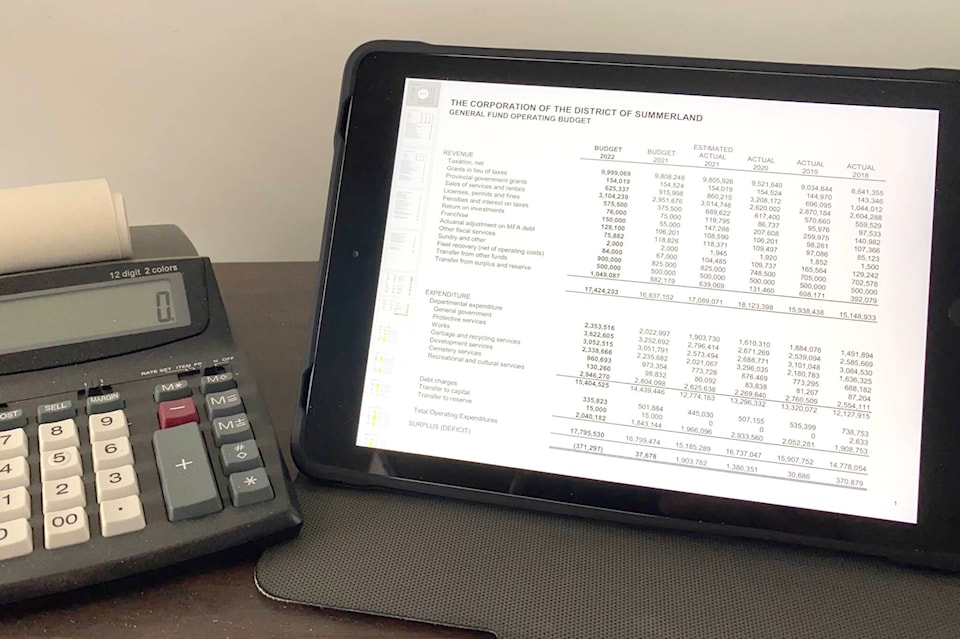This column is about the 2022 proposed budget – specifically the budgeted annual contributions to utility reserves (water, sewer and electric) and the general fund. Our objective is to answer questions you may have about these District of Summerland’s reserve accounts:
• Who allocates the money?
• What are reserve funds?
• Why do we have these reserve funds?
• Where do the annual contributions go?
• When is the money used?
• How much money is allocated?
• How can reserve money be spent?
• How do utility rate increases contribute to the reserves?
• Why do I have to pay something I may not benefit from?
READ ALSO: Summerland budget expected to increase
READ ALSO: Summerland utility rates to rise
Municipal government budgets include legislative reserves (required by the provincial government,) statutory reserves (established by council for specific purposes) and several other reserve or surplus accounts (sometimes known as “unallocated surplus” or surpluses not specifically allocated to a particular project.)
Budgeted annual reserve contributions have increased from approximately $1.04 million in 2016 to a proposed $4.07 million in 2022, with overall reserve balances increasing from roughly $14.2 million to $22.5 million at the end of 2021.
These increases are a direct result of council initiatives and directions over the years.
Who allocates the money? Each year since 2016, council has earmarked reserve contributions to the general fund and to each of the utility funds. (Allocations are made to other reserves, such as fire, landfill and climate action reserves, to name a few.)
What are reserve funds? Reserve funds, as their name implies, are monies set aside for future expenditures. Three of the four funds (water, sewer and general) include contributions from Development Cost Charges (the statutory payment made related to development in the district) and capital reserves (as directed in clause 4.3.3. of council’s Assessment Management Policy). The fourth, the electric fund, does not have a Development Cost Charges contribution but does have a capital reserve contribution.
Why do we have these reserve funds? Annual contributions to these reserve funds help cover capital expenditures, for example upgrades to the infrastructure that ensures clean drinking water comes out of your kitchen tap. Upgrading or replacing infrastructure is expensive.
Setting money aside – just as one might to pay for an anticipated appliance or hot water tank replacement – is good fiscal management.
Where do the annual contributions go? The reserve money is tracked separately and invested until it is needed to fund a project.
When is the money used? The money is used to cover capital expenditures, such as UV disinfection upgrades at the wastewater treatment plant, or replacing the water main on Canyon View Road.
How much money is allocated? For 2022, it is proposed that the general fund contribution be $2.06 million; the water fund contribution be just under $950,000, the sewer fund contribution be about $430,000 and the electric fund contribution be $626,000. Council determines the general fund allocation when setting proposed property tax increases.
How can reserve money be spent? Reserves should only be used for upgrading or replacing infrastructure/capital investment in that particular fund. For example, water fund contributions are used to fund water projects.
How do utility rate increases contribute to the reserves? Since 2017, council has set an annual five per cent increase to water rates; a five per cent sewer rate increase for each year from 2017 to 2019, then 3.5 per cent from 2020 to 2022 and a 3.5 per cent increase in electric rates in 2020 and 1.75 per cent increase in 2022. These increases are all specific to asset management reserve contributions.
Why do I have to pay something I may not benefit from? Look at this way: Our children or grandchildren may benefit in the future, just as we are benefiting from infrastructure expenditures made by residents in the past.
Two other notable annual transfers made directly to the asset management reserve. As debt matures, the maturing amount is transferred into the asset management reserve, as are the gravel royalties and gravel lease payments (approximately $100,000 per year.)
Toni Boot is the mayor of Summerland
To report a typo, email:
news@summerlandreview.com.
news@summerlandreview.com
Like us on Facebook and follow us on Twitter.
